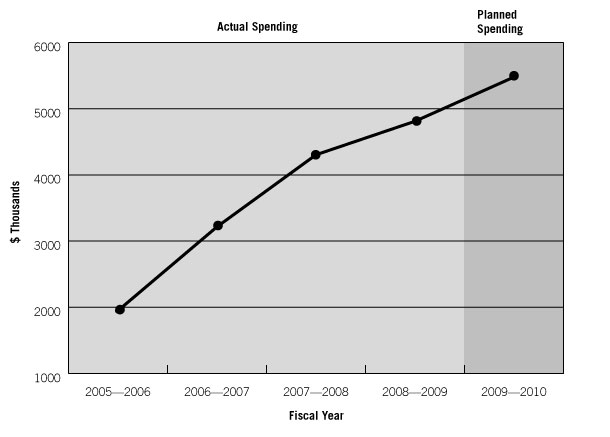Common menu bar links
Breadcrumb Trail
ARCHIVED - Public Service Staffing Tribunal
 This page has been archived.
This page has been archived.
Archived Content
Information identified as archived on the Web is for reference, research or recordkeeping purposes. It has not been altered or updated after the date of archiving. Web pages that are archived on the Web are not subject to the Government of Canada Web Standards. As per the Communications Policy of the Government of Canada, you can request alternate formats on the "Contact Us" page.
Chairperson’s Message

One of my main objectives, as Chair of the Public Service Staffing Tribunal (PSST), has been to ensure that the parties to a complaint before the PSST are offered several opportunities to resolve their differences before proceeding to an oral hearing.
This approach is in keeping with the spirit and intent of the Public Service Employment Act (PSEA) to promote effective dialogue which is the basis of most, if not all, successful alternative dispute methods. Throughout my experience as an adjudicator and mediator, I have found that a solution arrived at by the parties involved in a dispute is always preferable to one imposed by a third party.
Communication and sustained dialogue between employees and managers will ultimately build effective labour relations and thus strengthen the ability of the public service to serve the Canadian public. In this context, I believe that the PSST has contributed to a modern public service by helping the parties to a complaint come to a resolution of the complaint without an oral hearing.
Statistics for the year 2008-2009 bear this out. During the year, the Tribunal dealt with a total of 1,214 case files – 821 new complaints were received, while 393 were carried over from the previous year. In cases where the Tribunal lacked jurisdiction to consider a complaint, a complaint was untimely or a formal hearing was not required, the Tribunal was able to proceed quickly on the basis of written submissions from the parties. The Tribunal issued 166 final decisions in such cases.
The vast majority of the remaining cases were resolved at various other steps in the process – for example, during the exchange of information or after a pre-hearing conference. Only 34 cases proceeded to an oral hearing and thus to Reasons for Decision by the Tribunal.
It is my sincere hope that parties to a complaint before the Tribunal will continue to take advantage of the numerous opportunities provided to them both within their own organizations and during the Tribunal’s complaint process in order to resolve their differences themselves, thereby helping to improve labour relations and ensure that Canada’s public service embodies fair, transparent employment practices, respect for employees and effective dialogue.
Guy Gigučre
Chairperson and Chief Executive Officer
Section I: Departmental Overview
Raison d’ętre
The Public Service Staffing Tribunal is an independent, quasi-judicial body established under the Public Service Employment Act (PSEA) to deal with complaints related to internal appointments and lay-offs in the federal public service. The Tribunal conducts hearings and provides mediation services in order to resolve complaints.
Responsibilities
The Public Service Staffing Tribunal was established with the coming-into-force of the new PSEA on December 31, 2005 as part of the new arrangements for staffing recourse. The legislative mandate of the Tribunal is to consider and dispose of complaints dealing with lay-offs, revocation of appointments, internal appointments and the failure of corrective action. Under the Act, the Tribunal is also authorized to provide mediation services at any stage of a proceeding in order to resolve a complaint.
Strategic Outcome |
|---|
| Fair and impartial resolution of disputes related to internal appointments and lay-offs in the Government of Canada |
Program Activity |
Adjudication and mediation of complaints under the Public Service Employment Act |
Expected Results |
|
Outputs |
|
Summary of Performance
The Tribunal’s financial resources had a direct impact on its ability to achieve its Strategic Outcome and deliver its activities. The following sections highlight the Tribunal’s performance and demonstrate linkages between resources and results.
At the outset of the 2008-2009 fiscal year, the Tribunal’s planned spending was $5.0 million. Through Main Estimates and Supplementary Estimates, the Tribunal was allocated total authorities of $5.5 million and its actual spending was $4.8 million. This increase in authorities came from funding for the operating budget carry-forward and for wage increases.
| Planned Spending | Total Authorities | Actual Spending |
|---|---|---|
| 4,968 | 5,489 | 4,810 |
| Planned | Actual | Difference |
|---|---|---|
| 35 | 34 | 1 |
Performance Summary
| Performance Indicators | Targets | 2008-2009 Performance |
|---|---|---|
| Percentage of complaints referred to judicial review on the grounds that the Tribunal failed to observe a principle of natural justice, procedural fairness or other procedure | 3% | The Tribunal exceeded its target in 2008-2009 as 1.4% of the decisions issued by the Tribunal in 2008-2009 were referred to judicial review. Of the 210 final decisions (44 with Reasons for Decision and 166 letter decisions) issued, three applications to the Federal Court for judicial review were made on the grounds that the Tribunal failed to observe a principle of natural justice, procedural fairness or other procedure. |
| Program Activity | 2007-2008 Actual Spending ($ thousands) |
2008-2009 | Alignment to Government of Canada Outcomes | |||
|---|---|---|---|---|---|---|
| Main Estimates ($ thousands) |
Planned Spending ($ thousands) |
Total Authorities ($ thousands) |
Actual Spending ($ thousands) |
|||
| Adjudication and mediation of complaints filed under the Public Service Employment Act | 4,304 | 4,968 | 4,968 | 5,489 | 4,810 | The PSST contributes to the achievement of the Government of Canada’s “Government Affairs” Outcome by supporting an effective human resources management and a highly effective and competent public service. |
| Total | 4,304 | 4,968 | 4,968 | 5,489 | 4,810 | |
Contribution of Priorities to Strategic Outcome
Given its very specific mandate, the Tribunal’s two main operational priorities are directly related to both its Strategic Outcome and Program Activity.
| Operational Priorities | Type | Status | Links to Strategic Outcome |
|---|---|---|---|
| 1. Consider and dispose of complaints | Ongoing | Exceeded expectations Out of a total of 1,214 complaints processed during the year, only 210 final decisions (including both Reasons for Decision and letter decisions) were issued. Of the 210 final decisions issued, only three applications to the Federal Court for judicial review were made on the grounds that the Tribunal failed to observe a principle of natural justice, procedural fairness or other procedure. |
The fair and impartial resolution of complaints submitted to the Tribunal is achieved as informally and as expeditiously as possible through the various opportunities offered by the Tribunal for alternative dispute resolution and an effective internal review process. |
| 2. Provide mediation services | Ongoing | Exceeded expectations Of the 175 mediation sessions held, 158 – or 90% - resulted in a withdrawal of the complaint. The Tribunal’s target for the percentage of complaints settled by mediation is 70%. |
A settlement arrived at by the parties with the assistance of a Tribunal mediator is a “win-win” solution. With the help of a mediator, the parties themselves determine the outcome of the process and are more likely to be satisfied with the process in general, and the results in particular. |
| Management Priorities | Type | Status | Links to Strategic Outcome |
|---|---|---|---|
| 1. Strengthen corporate services | Ongoing | Met The Tribunal has put in place policies and procedures in the following areas: security and finance. Significant progress was made during the year on the development and implementation of the Tribunal’s information system. |
Having a solid infrastructure in place provides a foundation for the Tribunal to be able to fulfill its mandate. |
| 2. Strengthen human resources management | Ongoing | Met The Tribunal developed an integrated human resources and business plan, an employee assistance policy and learning and development program for its staff. |
A satisifed workforce and healthy workplace lead to greater productivity and thus contribute to the accomplishment of the Tribunal’s objectives. |
Risk Analysis
The Tribunal entered its third year of operations without a source of permanent funding and it was at risk of being distracted from its mandate by concerns about a serious shortage of funds.
However, in April 2008, the Prime Minister of Canada announced that six organizations with central human resources management functions – the Canada Public Service Agency, the Canada School of Public Service, the Public Service Commission, the Public Service Labour Relations Board, the Treasury Board of Canada and the Tribunal − were to complete a strategic review of their direct program spending by July 1st to ensure that their programs were relevant, were being managed efficiently and effectively and that they provided value for money.
The results of the review were announced by the Prime Minister on February 6, 2009. A number of changes in the governance structure for the management of human resources in the Public Service were made; the importance of ensuring long-term funding for the Tribunal was recognized and funds were set aside in Budget 2009 for this purpose.
The greatest challenge faced by the Tribunal occurred during the second half of the fiscal year. By the end of January 2009, only two permanent members remained to issue letter decisions, conduct hearings and render decisions. Selection processes for vacant member positions were initiated through the Privy Council Office, but did not yield any results before the end of the year. The delay in the appointment of new members in order to restore the full complement of five to seven permanent members had a significant effect upon the time it took the Tribunal to issue decisions.
Other risks identified as having a possible impact on the Tribunal’s operations during 2008-2009 included: an increase in the number of complaints as a result of higher number of collective staffing processes in departments, agencies, along with limited resources and the fact that the bargaining agents had to deal with an increased volume of complaints. To handle and monitor its own caseload, the Tribunal continued to fine-tune its complaint procedures and build the capacity of its case management system. With respect to the need to ensure that its stakeholders have the necessary information to handle complaints, the Tribunal updated its website regularly, developed and posted a revised Policy for Mediation and Hearing Scheduling and Requests for Postponements and continued to deliver information sessions to organizations, as requested.
Expenditure Profile
The Tribunal’s actual spending was $4.8 million in 2008-2009. The Tribunal’s expenditures have increased since the PSEA came into force in December 2005 because the number of complaints filed with the Tribunal has risen every year since then. Since its establishment in 2005, the Tribunal has steadily built up its capacity and invested in its infrastructure to deliver its activities.
The Tribunal was originally established with a planned expenditures budget of $5 million on the assumption that approximately 400 complaints would be submitted per year. This number was reached in the Tribunal’s second year of operations (2006-2007). Seven hundred forty-two (742) complaints were received in 2007-2008 and 821, in 2008-2009. Despite the 10% increase in the number of complaints, the Tribunal has continued to operate within the resources that were originally allocated.
The chart below shows the Tribunal’s spending trend over a five-year period including planned spending for the fiscal year 2009-2010.

| Voted or Statutory Items | 2006-2007 Actual Spending ($ thousands) |
2007-2008 Actual Spending ($ thousands) |
2008-2009 Main Estimates ($ thousands) |
2008-2009 Actual Spending ($ thousands) |
|
|---|---|---|---|---|---|
| 90 | Program expenditures | 2,903.1 | 3,902.0 | 4,481.0 | 4,325.0 |
| (S) | Contributions to employee benefit plans | 312.8 | 402.0 | 487.0 | 485.0 |
| Total | 3,215.9 | 4,304.0 | 4,968.0 | 4,810.0 | |
